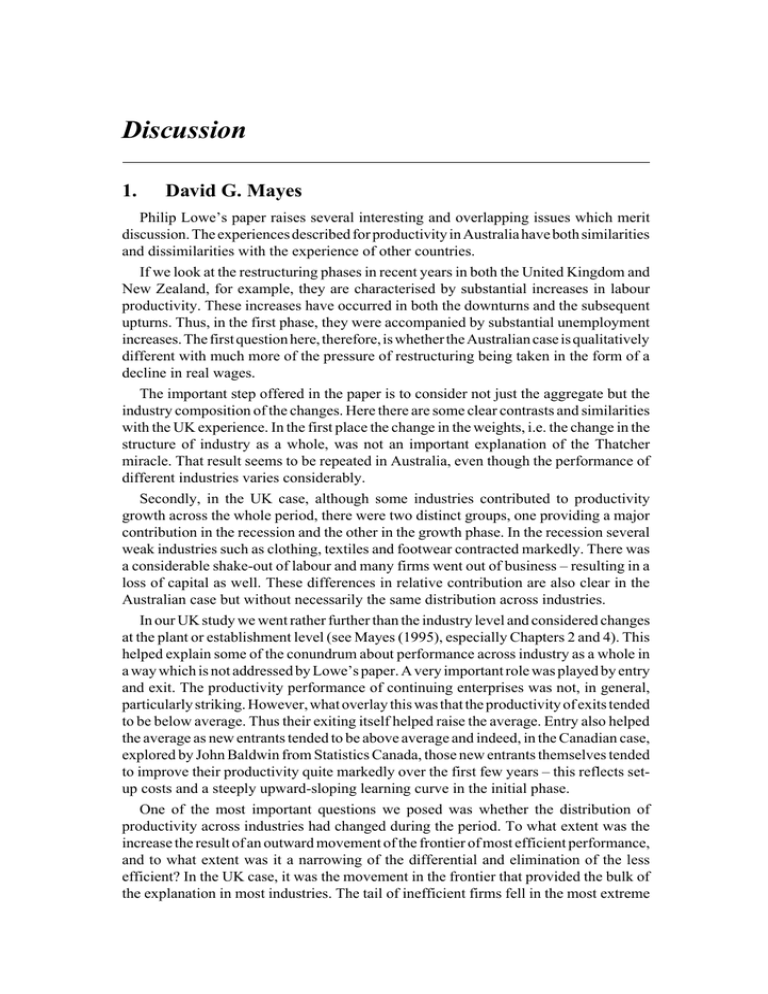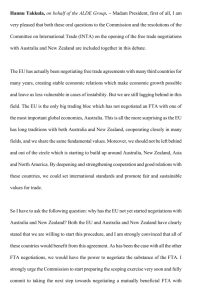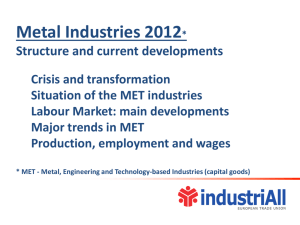Discussion 1. David G. Mayes
advertisement

Discussion 1. David G. Mayes Philip Lowe’s paper raises several interesting and overlapping issues which merit discussion. The experiences described for productivity in Australia have both similarities and dissimilarities with the experience of other countries. If we look at the restructuring phases in recent years in both the United Kingdom and New Zealand, for example, they are characterised by substantial increases in labour productivity. These increases have occurred in both the downturns and the subsequent upturns. Thus, in the first phase, they were accompanied by substantial unemployment increases. The first question here, therefore, is whether the Australian case is qualitatively different with much more of the pressure of restructuring being taken in the form of a decline in real wages. The important step offered in the paper is to consider not just the aggregate but the industry composition of the changes. Here there are some clear contrasts and similarities with the UK experience. In the first place the change in the weights, i.e. the change in the structure of industry as a whole, was not an important explanation of the Thatcher miracle. That result seems to be repeated in Australia, even though the performance of different industries varies considerably. Secondly, in the UK case, although some industries contributed to productivity growth across the whole period, there were two distinct groups, one providing a major contribution in the recession and the other in the growth phase. In the recession several weak industries such as clothing, textiles and footwear contracted markedly. There was a considerable shake-out of labour and many firms went out of business – resulting in a loss of capital as well. These differences in relative contribution are also clear in the Australian case but without necessarily the same distribution across industries. In our UK study we went rather further than the industry level and considered changes at the plant or establishment level (see Mayes (1995), especially Chapters 2 and 4). This helped explain some of the conundrum about performance across industry as a whole in a way which is not addressed by Lowe’s paper. A very important role was played by entry and exit. The productivity performance of continuing enterprises was not, in general, particularly striking. However, what overlay this was that the productivity of exits tended to be below average. Thus their exiting itself helped raise the average. Entry also helped the average as new entrants tended to be above average and indeed, in the Canadian case, explored by John Baldwin from Statistics Canada, those new entrants themselves tended to improve their productivity quite markedly over the first few years – this reflects setup costs and a steeply upward-sloping learning curve in the initial phase. One of the most important questions we posed was whether the distribution of productivity across industries had changed during the period. To what extent was the increase the result of an outward movement of the frontier of most efficient performance, and to what extent was it a narrowing of the differential and elimination of the less efficient? In the UK case, it was the movement in the frontier that provided the bulk of the explanation in most industries. The tail of inefficient firms fell in the most extreme 136 Discussion cases but the general contribution was more limited. To some extent this reflects our methodology. We estimated trans-log production functions with a residual split into stochastic and efficiency components. In an earlier book we made a detailed comparison of the UK and Australia for the common year, 1977 (Mayes , Harris and Lansbury 1994). But while we have repeated this exercise for the whole of the 1980s this has not, as far as I know, been replicated for Australia. Lowe points to some of these differences in structure when he considers the role of changes in scale in retailing but the main emphasis in the paper is on two further compositional elements. One is the failure to capture changes in the quality of output, particularly in the service industries which contribute an important component to the slow growth of productivity in the economy as a whole, and the second is the change in the structure of employment with changes in the skill mix. I have enormous sympathy for most of these arguments as many of the aggregate results seem counter-intuitive. In the New Zealand case, many of the changes are obvious and well documented. New Zealand Rail, for example, used to employ around 20,000 people. It has reduced that to a quarter but it now runs more trains. By rescheduling shipping it is possible to move goods between Auckland and Christchurch within 24 hours. But this process of change extends beyond Air New Zealand, New Zealand Post, etc. into many other publicly-owned service enterprises where the change in quality of service and efficiency has been substantial. Nevertheless this does not come out in the figures. Local government charges have been rising in recent years but this is a function not of increased wages but increased quality and range of services. (This is, of course, a major source of frustration for a central bank changed with maintaining price stability as these quality improvements are treated as price increases and hence feature in the CPI.) I suspect Lowe is quite correct to emphasise this source of missed productivity increase. It also seems inconceivable to me that the IT revolution has not had a dramatic impact on many service sectors. One does not have to look far afield to be aware of it. The Reserve Bank of Australia has been a beneficiary in exactly the same way as the Reserve Bank of New Zealand. The number of staff required to implement policy has fallen dramatically, the quality of advice has improved and productivity in terms of papers written, forecasts made, etc. has increased out of all proportion. The figures shown for the finance, property and business services sectors seem unbelievable and case studies, including one in this Volume, contradict it. A second facet Lowe points to is the rise of part-time employment and increase in less productive jobs alongside the more rapid increase in the productivity of existing jobs which, in part, helps to explain the discrepancy in the statistics. It is certainly the case in the New Zealand recovery of the past few years that although the recovery has been driven by exporting and major productivity growth, when we look at the economy as a whole, the productivity performance is not particularly impressive. This reflects the growth of service sector jobs, in some cases part-time employment. Unemployment has fallen faster and employment risen faster than was anticipated even with the rapid growth we have experienced. The high productivity growth has occurred, but the growth has generated a second round of more labour-intensive activities as the increased incomes are spent. It is noticeable that the current recovery has not resulted in the traditional rush of imports of consumer goods. Imports have increased, but it is imported capital equipment which has been a more important contributor. Labour-Productivity Growth and Relative Wages: 1978-1994 137 It should, therefore, be clear that much of the apparent productivity puzzle can be unlocked by considering a more disaggregate picture both in terms of firms and employees. One needs to consider the dynamics of the market both in terms of entry and exit for firms, and the distinction between behaviour in an existing job and movement from and into jobs for the labour market. The measurement issue is, if anything, likely to be more severe than is suggested in the paper. I have said virtually nothing about the relative wage facet of the paper as I have little in the way of new information to add to it but, assuming moderate labour-market flexibility, Lowe’s view that relative wages will act as an indicator seems very reasonable. It is much harder to decide whether Australia is embarked on a new higherproductivity trend. All one can point out from the New Zealand and UK experiences is that it is easy to talk oneself into this belief. Practice, however, seems to be much more resilient and while optimism is to be welcomed, I would expect the Reserve Bank of Australia to be pretty cautious in assessing the degree to which trend productivity has risen even allowing for changes in its sectoral composition. References Mayes, D.G., C.M. Harris and M. Lansbury (1994), Inefficiency in Industry, Harvester Wheatsheaf, Hemel Hempstead. Mayes, D.G. (ed.)(1995), Sources of Productivity Growth, Cambridge University Press, Cambridge (forthcoming). 2. General Discussion The discussion was focussed on the following practical issues and their implications: • the proper measurement of output and productivity; and • interpretation of the observed relationship between productivity and wages at the sectoral level in Australia. A key measurement issue was considered to be the heterogeneous nature of intermediate industries – such as finance, property and business services – where some of their services should properly be treated as an intermediate input rather than an output. However, while changes in the measured output of sectors producing intermediate goods would change the measured productivity growth in these sectors, it may not have any effect on aggregate productivity growth since it may reduce value added in other industries. It was also emphasised that fundamental measurement problems arise in industries where it is difficult to identify the market value of output. Again, reference was made to finance, property and business services. For this industry, output in a base year is extrapolated using data on hours worked. Consequently, labour productivity in that sector – national accounts-based output divided by hours worked – was actually one measure of output divided by another, with the resultant productivity measure being the observed inconsistency between the series. 138 Discussion Other important measurement issues related to the nature of the survey data from which measures of output are derived. It was noted that quite a different picture about productivity in wholesale and retail trade, for example, could be identified by reference to surveys of establishments or management units rather than the national accounts. This led to a discussion about how survey information could be better utilised to identify changes in quality, such as consumer convenience, which presently make valuation of the output of service-oriented industries so difficult. Given these practical problems in the measurement of productivity, there was wideranging discussion about how the observed relationship between productivity, wages and prices should be interpreted. The main results of the paper were related to Baumol’s unbalanced growth model in which, with a common equilibrium wage, divergent productivity across the economy causes a divergence in relative prices. An interesting historical perspective was provided. It was noted that, using the same type of analysis, Australian researchers in the 1950s and 1960s had found similar results, suggesting that the findings were robust to the type of wage-fixing system. The attainment of a common equilibrium wage does, however, require labour mobility. Consequently, it was argued that some comment on the extent of labour mobility was appropriate. According to some participants, the paper implied that industries which experienced the largest increases in their relative prices (those with the poorest productivity performance) also experienced the largest increases in employment. A discussion followed on the role that the demand side played in driving this result; perhaps those industries with the least scope for productivity improvements have the highest income elasticities. It was suggested that general increases in living standards force up the price of output in these industries and this allows additional workers to be employed, even though their marginal contribution to output is relatively small. It was suggested that the paper could more fully explore these demand influences on productivity outcomes. Finally, in discussion pertinent to a small open economy, it was argued that terms of trade shocks can play a major role in the relationship between the marginal product of labour and the real product wage. A scenario was presented in which rising commodity prices increased Australia’s terms of trade so that, for some sectors, the real product wage fell, and was driven below marginal product. As a result, in the affected industry, labour input is increased and investment is reduced, causing the capital/labour ratio to fall. This was described as the optimal response to the terms of trade shock. It was emphasised that the relationships between productivity, prices and wages evident in the data are contingent upon the effect of exogenous shocks, such as the terms of trade.






